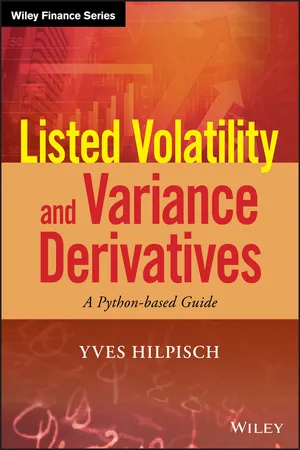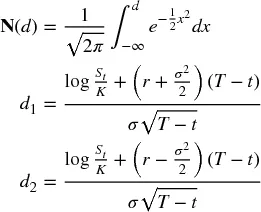
Listed Volatility and Variance Derivatives
A Python-based Guide
Yves Hilpisch
- English
- ePUB (mobile friendly)
- Available on iOS & Android
Listed Volatility and Variance Derivatives
A Python-based Guide
Yves Hilpisch
About This Book
Leverage Python for expert-level volatility and variance derivative trading
Listed Volatility and Variance Derivatives is a comprehensive treatment of all aspects of these increasingly popular derivatives products, and has the distinction of being both the first to cover European volatility and variance products provided by Eurex and the first to offer Python code for implementing comprehensive quantitative analyses of these financial products. For those who want to get started right away, the book is accompanied by a dedicated Web page and a Github repository that includes all the code from the book for easy replication and use, as well as a hosted version of all the code for immediate execution.
Python is fast making inroads into financial modelling and derivatives analytics, and recent developments allow Python to be as fast as pure C++ or C while consisting generally of only 10% of the code lines associated with the compiled languages. This complete guide offers rare insight into the use of Python to undertake complex quantitative analyses of listed volatility and variance derivatives.
- Learn how to use Python for data and financial analysis, and reproduce stylised facts on volatility and variance markets
- Gain an understanding of the fundamental techniques of modelling volatility and variance and the model-free replication of variance
- Familiarise yourself with micro structure elements of the markets for listed volatility and variance derivatives
- Reproduce all results and graphics with IPython/Jupyter Notebooks and Python codes that accompany the book
Listed Volatility and Variance Derivatives is the complete guide to Python-based quantitative analysis of these Eurex derivatives products.
Frequently asked questions
Part One
Introduction to Volatility and Variance
CHAPTER 1
Derivatives, Volatility and Variance
1.1 Option Pricing and Hedging






Table of contents
- Cover
- Title Page
- Copyright
- Dedication
- Preface
- Part One: Introduction to Volatility and Variance
- Part Two: Listed Volatility Derivatives
- Part Three: Listed Variance Derivatives
- Part Four: DX Analytics
- Bibliography
- Index
- EULA